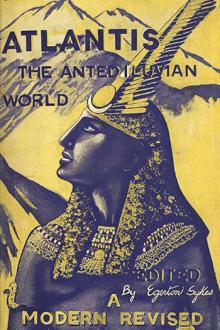Atlantis: The Antedeluvian World by Ignatius Donnelly (thriller novels to read .TXT) 📕

- Author: Ignatius Donnelly
- Performer: -
Book online «Atlantis: The Antedeluvian World by Ignatius Donnelly (thriller novels to read .TXT) 📕». Author Ignatius Donnelly
The first thought that occurs to us on examining the Landa alphabet is the complex and ornate character of the letters. Instead of the two or three strokes with which we indicate a sign for a sound, we have here rude pictures of objects. And we find that these are themselves simplifications of older forms of a still more complex character. Take, for instance, the letter pp in Landa’s alphabet, ### : here are evidently the traces of a face. The same appear, but not so plainly, in the sign for x, which is ### . Now, if we turn to the ancient hieroglyphics upon the monuments of Central America, we will find the human face appearing in a great many of them, as in the following, which we copy from the Tablet of the Cross at Palenque. We take the hieroglyphs from the left-hand side of the inscription. Here it will be seen that, out of seven hieroglyphical figures, six contain human faces.
And we find that in the whole inscription of the Tablet of the Cross there are 33 figures out of 108 that are made up in part of the human countenance.
###
We can see, therefore, in the Landa alphabet a tendency to simplification. And this is what we would naturally expect. When the emblems—which were probably first intended for religious inscriptions, where they could be slowly and carefully elaborated—were placed in the bands of a busy, active, commercial people, such as were the Atlanteans, and afterward the Phœnicians, men with whom time was valuable, the natural tendency would be to simplify and condense them; and when the original meaning of the picture was lost, they would naturally slur it, as we find in the letters pp and x of the Maya alphabet, where the figure of the human face remains only in rude lines.
The same tendency is plainly shown in the two forms of the letter h, as given in Landa’s alphabet; the original form is more elaborate than the variation of it. The original form is ### The variation is given as ###
. Now let us suppose this simplification to be carried a step farther: we have seen the upper and lower parts of the first form shrink into a smaller and less elaborate shape; let us imagine that the same tendency does away with them altogether; we would then have the letter H of the Maya alphabet represented by this figure, ### ; now, as it takes less time to make a single stroke than a double one, this would become in time ### . We turn now to the archaic Greek and the old Hebrew, and we find the letter h indicated by this sign, ### , precisely the Maya letter h simplified. We turn to the archaic Hebrew, and we find ### .
Now it is known that the Phœnicians wrote from right to left, and just as we in writing from left to right slope our letters to the right, so did the Phœnicians slope their letters to the left. Hence the Maya sign becomes in the archaic Phœnician this, ### . In some of the Phœnician alphabets we even find the letter h made with the double strokes above and below, as in the Maya h. The Egyptian hieroglyph for h is ### while ch is ### . In time the Greeks carried the work of simplification still farther, and eliminated the top lines, as we have supposed the Atlanteans to have eliminated the double strokes, and they left the letter as it has come down to us, H.
Now it may be said that all this is coincidence. If it is, it is certainly remarkable. But let us go a step farther: We have seen in Landa’s alphabet that there are two forms of the letter m. The first is ### . But we find also an m combined with the letter o, a, or e, says Landa, in this form, ### . The m here is certainly indicated by the central part of this combination, the figure ### ; where does that come from? It is clearly taken from the heart of the original figure wherein it appears. What does this prove? That the Atlanteans, or Mayas, when they sought to simplify their letters and combine them with others, took from the centre of the ornate hieroglyphical figure some characteristic mark with which they represented the whole figure. Now let us apply this rule: We have seen in the table of alphabets that in every language, from our own day to the time of the Phœnicians, o has been represented by a circle or a circle within a circle. Now where did the Phœnicians get it?
Clearly from the Mayas. There are two figures for o in the Maya alphabet; they are ### and ### ; now, if we apply the rule which we have seen to exist in the case of the Maya m to these figures, the essential characteristic found in each is the circle, in the first case pendant from the hieroglyph; in the other, in the centre of the lower part of it. And that this circle was withdrawn from the hieroglyph, and used alone, as in the case of the m, is proved by the very sign used at the foot of Landa’s alphabet, which is, ### Landa calls this ma, me, or mo; it is probably the latter, and in it we have the circle detached from the hieroglyph.
We find the precise Maya o a circle in a circle, or a dot within a circle, repeated in the Phœnician forms for o, thus, ### and ### , and by exactly the same forms in the Egyptian hieroglyphics; in the Runic we have the circle in the circle; in one form of the Greek o the dot was placed along-side of the circle instead of below it, as in the Maya.
Are these another set of coincidences?
Take another letter:
The letter n of the Maya alphabet is represented by this sign, itself probably a simplification of some more ornate form, ### . This is something like our letter S, but quite unlike our N. But let us examine into the pedigree of our n. We find in the archaic Ethiopian, a language as old as the Egyptian, and which represents the Cushite branch of the Atlantean stock, the sign for n (na) is ### ; in archaic Phœnician it comes still closer to the S shape, thus, ### , or in this form, ### ; we have but to curve these angles to approximate it very closely to the Maya n; in Troy this form was found, ### . The Samaritan makes it ### ; the old Hebrew ### ; the Moab stone inscription gives it ### ; the later Phœnicians simplified the archaic form still further, until it became ### ; then it passed into ### : the archaic Greek form is ### ; the later Greeks made ### , from which it passed into the present form, N.
All these forms seem to be representations of a serpent; we turn to the valley of the Nile, and we find that the Egyptian hieroglyphic for n was the serpent, ### ; the Pelasgian n was ### ; the Arcadian, ### ; the Etruscan, ### .
Can anything be more significant than to find the serpent the sign for n in Central America, and in all these Old World languages?
Now turn to the letter k. The Maya sign for k is ### . This does not look much like our letter K; but let us examine it. Following the precedent established for us by the Mayas in the case of the letter m, let us see what is the distinguishing feature here; it is clearly the figure of a serpent standing erect, with its tail doubled around its middle, forming a circle. It has already been remarked by Savolini that this erect serpent is very much like the Egyptian Uræus, an erect serpent with an enlarged body—a sacred emblem found in the hair of their deities. We turn again to the valley of the Nile, and we find that the Egyptian hieroglyphic for k was a serpent with a convolution or protuberance in the middle, precisely as in the Maya, thus, ### ; this was transformed into the Egyptian letter ### ; the serpent and the protuberance reappear in one of the Phœnician forms of k, to wit, ### ; while in the Punic we have these forms, ### and ### . Now suppose a busy people trying to give this sign: instead of drawing the serpent in all its details they would abbreviate it into something like this, ### ; now we turn to the ancient Ethiopian sign for k (ka), and we have ### , or the Himyaritic Arabian ### ; while in the Phœnician it becomes ### ; in the archaic Greek, ### ; and in the later Greek, when they changed the writing from left to right, ### . So that the two lines projecting from the upright stroke of our English K are a reminiscence of the convolution of the serpent in the Maya original and the Egyptian copy.
Turn now to the Maya sign for t: it is ### , . What is the distinctive mark about this figure? It is the cross composed of two curved lines, thus, ### . It is probable that in the Maya sign the cross is united at the bottom, like a figure 8. Here again we turn to the valley of the Nile, and we find that the Egyptian hieroglyph for t is ### and ### ; and in the Syriac t it is ### . We even find the curved lines of the Maya t which give it something of the appearance of the numeral 8, repeated accurately in the Mediterranean alphabets; thus the Punic t repeats the Maya form almost exactly as ### and ### . Now suppose a busy people compelled to make this mark every day for a thousand years, and generally in a hurry, and the cross would soon be made without curving the lines; it would become X. But before it reached even that simplified form it had crossed the Atlantic, and appeared in the archaic Ethiopian sign for tsa, thus, ### . In the archaic Phœnician the sign for ### is ### and ### ; the oldest Greek form is ### or ### and the later Greeks gave it to the Romans ### , and modified this into ### ; the old Hebrew gave it as ### and ### ; the Moab stone as ### ; this became in time ###
and ### .
Take the letter a. In the Maya there are three forms given for this letter. The first is ### ; the third is ### . The first looks very much like the foot of a lion or tiger; the third is plainly a foot or boot.
If one were required to give hurriedly a rude outline of either of these, would he not represent it thus, ### ; and can we not conceive that this could have been in time modified into the Phœnician a, which was ### ? The hieratic Egyptian a was ### ;





Comments (0)